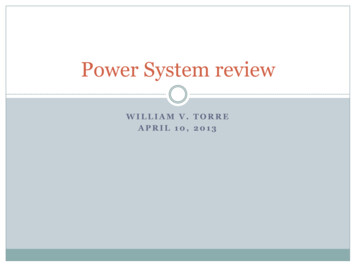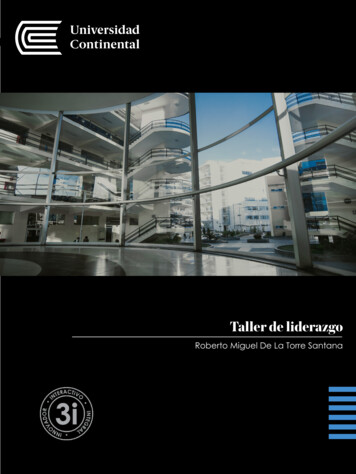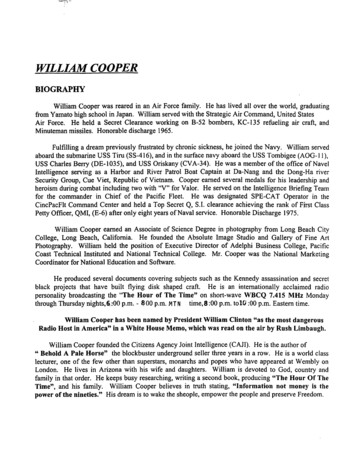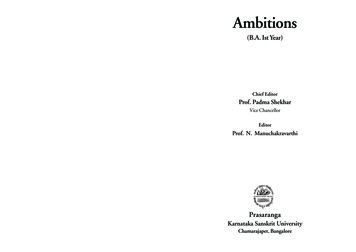
Transcription
Power System reviewWILLIAM V. TORREAPRIL 10, 2013
Basics of Power systems Network topologyTransmission and Distribution Load and Resource Balance Economic Dispatch Steady State System Analysis Power flow analysis Dynamic System Analysis Transient stability
Network Topology Transmission Lines High Voltage 69 kV – 500 kV Power Capacity 50 – 1,000 MW Carry power long distances P 3𝑉 𝐼 sin ƟLow energy losses , Ploss 𝐼2 𝑅Large structures
Power Transmission In the United States
Network Topology Distribution Circuits Primary; 12 – 34 kV AC Secondary: 480 V – 120 V AC Power capacity: 10 – 40 MW Shorter distances, higher losses Smaller overhead structures Underground Terminal equipmentTransformers Capacitors Lightning arresters Switches
Customer Load Customer Power Residential Single phase, 220 – 120 V, resistiveCommercial Three phase, 277 – 4,160 V, inductive Metering of Power Consumption Conventional meters Automatic Metering Infrastructure (AMI, aka: Smart Meter) Demand Response Automatic Manual
Generating Resources Different Types Fossil Fuel Hydroelectric Nuclear Geothermal RenewablePhotovoltaics Solar Thermal Wind Bio-gas
Power System Summary
Economic Dispatch of Generation What is economic dispatch?“The operation of generation facilities to produce energy at the lowestcost to reliably serve consumers, recognizing any operational limits ofgeneration and transmission facilities.” (EPAct Section 1234) There are two fundamental components to economicdispatch: Planning for tomorrow’s dispatchDispatching the power system today
Planning for Tomorrow Dispatch Scheduling generating units for each hour of the nextday’s dispatch Based on forecast load for the next daySelect generating units to be running and available fordispatch the next day (operating day)Recognize each generating unit’s operating limit, including its:Ramp rate (how quickly the generator’s output can be changed) Maximum and minimum generation levels Minimum amount of time the generator must run Minimum amount of time the generator must stay off once turnedoff
Planning for Tomorrow’s Dispatch Cont’d Recognize generating unit characteristics, including: Cost of generating, which depends on:its efficiency (heat rate) its variable operating costs (fuel and non-fuel) Variable cost of environmental compliance Start-up costs Next day scheduling is typically performed by ageneration group or an independent market operator
Reliability Assessment For Dispatch Analyze forecasted load and transmission conditionsin the area to ensure that scheduled generationdispatch can meet load reliably. If the scheduled dispatch is not feasible within thelimits of the transmission system, revise it. This reliability assessment is typically performed bya transmission operations group
Dispatching the Power System For Today Monitor load, generation and interchange (imports/exports) toensure balance of supply and load Monitor and maintain system frequency at 60 Hz during dispatch according toNERC standards, using Automatic GenerationControl (AGC) to change generation dispatch as neededMonitor hourly dispatch schedules to ensure that dispatch for the next hour willbe in balance Monitor flows on transmission system Keep transmission flows within reliability limitsKeep voltage levels within reliability rangesTake corrective action, when needed, by: Limiting new power flow schedulesCurtailing existing power flow schedulesChanging the dispatchShedding load This monitoring is typically performed by the transmission operator
Power Flow Analysis Assumes balanced three phase system Modeled as a single phase system A set of non-linear differential equations model boththe Real (watts) and Reactive (Vars) power flow Matrices are developed for all impedances oftransmission lines interconnecting substations(busses) Non-linear equations are solved through an iterativeprocess, with an assumed initial conditions
Three Phase AC Power System Three phases oscillating at 60 Hz, 120 degrees out ofphaseEAEBEC
Rotating Phasor Diagram of WaveformsEC120 120 120 EBEA
Power System Electrical Components Resistance (Ohms) E IR Inductance (Henry) Xl 2 f* L,E L(di/dt) Capacitance (Farads) Xc 1/2 *C, I C (dv/dt)
Transmission Line Model Transmission Lines consist of series resistance,inductance, and capacitance These components can be modeled as a compleximpedance Z, the inverse of Z is admittance Y
Power System RepresentationGeneratorLinks: Transmission LinesCustomer LoadsNodes: Buses (Substations)
Admittance MatrixWe define:Ybus [ Yij ] whereDiagonal Elements:Off‐diagonal Elements:Note that Ybas matrix depends on the power gridtopology and the admittance of all transmission lines. N is the number of busses in the grid.
Admittance Matrix Example Example of Admittance Matrix for four bus example: After separating the real and reactive parts:
Bus Voltage Let Vi denote the voltage at bus i Vi is a phasor with magnitude and angle
Power Flow Equations Substituting the admittance and voltage. The power flowequations become: We can solve these set of non-linear equations through iterativesolution techniques Gauss-Seidel Method – substitute voltages and solve equations, begin a newiteration using previously calculated voltages, until minimum tolerance isachievedNewton-Raphson Method – faster iterative solution using Taylor seriesexpansion Solution can be linearized, by making assumptions about suceptance, bus voltages,and power angle. Faster solution, less accurate for reactive power values.
Power Flow Simulation Scenarios Maintenance or Force Outage Response: Lossof power line, calculate load flow and determine ifoverloads will occur, re-disptach generation or dropload Sudden Change in generation: Generationforced outage, Renewable Generation change,determine transmission line overloads, re-dispatchgeneration Others?
Transient Stability Analysis of Power Systems Same set of non-linear power equations as steadystate power flow analysis Generator inertia and control system response isincluded Iterative time step solution is used to determinesystem response of each generator and active controlloop
Transient Stability Analysis Power transfer equation:
Equal Area Criteria for Transient StabilityCritical Clearing Angle A1 must be less than A2 for the system to have a stable response
Multi-Machine Stability Modern power systems are interconnected and operate close to theirtransient and steady state stability limits. In large interconnected systems, it is common to find a natural responseof a group of closely coupled machines oscillating against other groups ofmachines.
Transient Stability SimulationsUnstable ConditionPoorly Damped ResponseMarginally Damped ResponseCCT Critical Clearing Time
Multi – Machine ResponseFebruary 26, 2013 Load Rejection Denver, Co
Power System Review Summary Transmission and Distribution systems are extensiveand complex Fundamental defining power system equations arenon-linear and highly coupled Economic dispatch is becoming more difficult withadditional renewable resources, due to uncertainty Transient Stability analysis is an important tool toensure reliable power system operation
Questions
Dispatching the Power System For Today Monitor load, generation and interchange (imports/exports) to ensure balance of supply and load Monitor and maintain system frequency at 60 Hz during dispatch according to NERC standards, using Automatic Generation Control (AGC) to change generation dispatch as needed Monitor hourly dispatch schedules to ensure that dispatch for the next hour will










